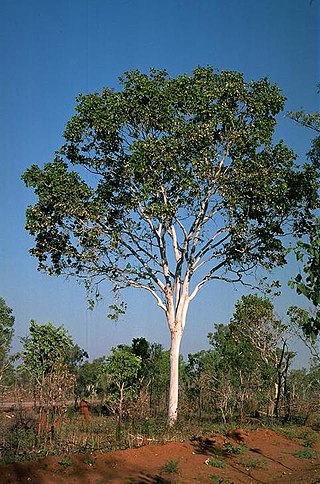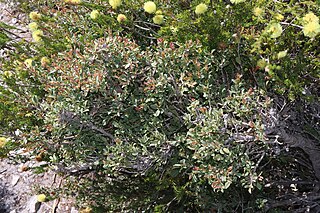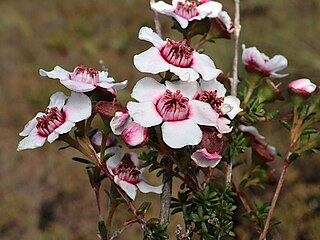
Agonis is a genus of flowering plants in the plant family Myrtaceae. All are endemic to Western Australia, growing near the coast in the south west. Plants in the genus Agonis are shrubs or trees with bisexual flowers arranged in heads in leaf axils with 5 sepals and usually 5 white petals, each with 15 to 30 stamens arranged opposite the sepals, and the fruit a woody capsule.

Agonis flexuosa, commonly known as peppermint, is a species of flowering plant in the family Myrtaceae and is endemic to the southwest of Western Australia. The Noongar peoples know the tree as wanil, wonnow, wonong or wannang. It is a tree or shrub with pendulous, very narrowly elliptic, narrowly elliptic or narrowly egg-shaped leaves, white flowers with 20 to 25 stamens opposite the sepals and broadly top-shaped to broadly cup-shaped capsules.

Taxandria juniperina commonly known as wattie, native cedar, Warren River cedar or juniper myrtle is a species of tree that grows in the south west corner of Western Australia. This plant was previously classified as Agonis juniperina but is now part of the genus Taxandria. The Noongar peoples know the tree as watti.

Eucalyptus grossa, commonly known as coarse-leaved mallee, is a species of mallee or rarely a straggly tree, that is endemic to Western Australia. It has rough, fibrous bark on the trunk and all but the thinnest branches, broadly lance-shaped to egg-shaped adult leaves, flower buds in groups of seven, yellowish green flowers and cup-shaped to cylindrical fruit.

Calytrix depressa is a species of flowering plant in the myrtle family Myrtaceae and is endemic to the south-west of Western Australia. It is a glabrous shrub with linear to lance-shaped leaves and mauve to violet or yellow flowers with 35 to 75 stamens in several rows.

Hibbertia vestita, commonly known as hairy guinea-flower, is a species of flowering plant in the family Dilleniaceae and is endemic to eastern Australia. It is a small shrub with foliage covered with simple hairs, usually linear leaves, and yellow flowers with 22 to 43 stamens with many staminodes arranged around three hairy carpels.

Corymbia grandifolia, commonly known as cabbage gum, large-leaved cabbage gum and paper-fruited bloodwood, is a species of tree that is endemic to northern Australia. It has smooth bark, egg-shaped to broadly elliptic to lance-shaped adult leaves, flowers buds in groups of three or seven, creamy white flowers and cup-shaped to cylindrical fruit.

Agonis baxteri is a species of flowering plant in the family Myrtaceae and is endemic to the southwest of Western Australia. It is an erect, sometimes bushy shrub with elliptic to egg-shaped leaves with the narrower end towards the base, and usually white flowers with 23 to 32 stamens.

Agonis theiformis is a species of flowering plant in the family Myrtaceae and is endemic to the southwest of Western Australia. It is a shrub with elliptic to egg-shaped, sometimes broadly egg-shaped leaves, and clusters of white flowers with mostly 15 to 20 stamens opposite the sepals, the fruit a spherical cluster of cup-shaped capsules.

Agonis undulata is a species of flowering plant in the family Myrtaceae, and is endemic to the Fitzgerald River National Park in the south of Western Australia. It is an erect shrub with more or less sessile, egg-shaped leaves with the narrower end towards the base, white flowers, and broadly cup-shaped capsules.
Baeckea pachyphylla is a species of flowering plant in the family Myrtaceae and is endemic to the south of Western Australia. It is a shrub with bilaterally flattened leaves and small white flowers with two to eight stamens.
Baeckea uncinella is a species of flowering plant in the family Myrtaceae and is endemic to the south coast of Western Australia. It is a shrub with narrowly egg-shaped to linear leaves and small white flowers with seven to thirteen stamens.

Calytrix asperula, commonly known as brush starflower, is a species of flowering plant in the myrtle family Myrtaceae and is endemic to the south of Western Australia. It is a mostly glabrous shrub with linear to narrowly elliptic leaves and cream-coloured to yellow flowers with 40 to 60 yellow stamens in several rows.
Leptospermopsis roei is a species of spreading shrub that is endemic to the southwest of Western Australia. It has thin, fibrous bark, long egg-shaped to narrow wedge-shaped leaves, white or pink flowers and small fruit that are shed with the seeds.

Leptospermopsis sericea, commonly known as the silver tea tree, is a species of shrub that is endemic to the south-west of Western Australia. It has thin, firm bark, egg-shaped leaves with the narrower end towards the base, relatively large, pink flowers and fruit that fall from the plant with the seeds. It grows in windswept rock crevices near Esperance.

Micromyrtus elobata is a species of flowering plant in the myrtle family, Myrtaceae and is endemic to the south of Western Australia. It is usually an erect shrub with small, narrowly to broadly egg-shaped leaves with the narrower end towards the base, and white flowers 3–5 mm (0.12–0.20 in) in diameter.
Micromyrtus imbricata is a species of the family Myrtaceae and is endemic to the south of Western Australia. It is a slender, erect shrub with broadly egg-shaped leaves, white, pink or red-tinged flowers 4–5 mm (0.16–0.20 in) in diameter, and 10 stamens.

Micromyrtus racemosa is species of the flowering plant in the family Myrtaceae and is endemic to the south-west of Western Australia. It is a shrub with relatively thick, narrowly egg-shaped leaves, sometimes with the narrower end toward the base, and white, cream-coloured or yellow flowers 2.5–4.0 mm (0.098–0.157 in) in diameter.

Babingtonia grandiflora, commonly known as the large flowered babingtonia, is a species of flowering plant in the family Myrtaceae and is endemic to the southwest of Western Australia. It is a shrub with erect or arching stems, linear leaves and white or pale pink flowers usually arranged singly in leaf axils, each flower with 11 to 25 stamens.

Olearia calcarea, commonly known as limestone daisy bush, is a species of flowering plant in the family Asteraceae and is endemic to southern continental Australia. It is a shrub with egg-shaped or broadly spoon-shaped leaves with toothed edges, and white and yellow, daisy-like inflorescences.















